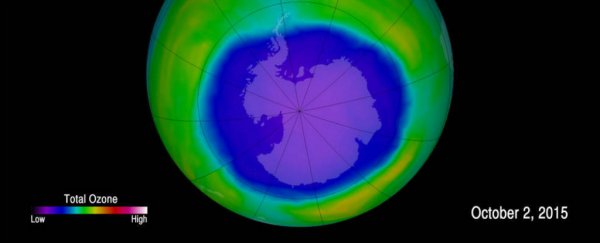While the famous Antarctic " ozone hole" is finally beginning to heal, 30 years after it was first discovered, scientists have just identified a new threat to its recovery.
A study, just out Tuesday in the journal Nature Communications, suggests that a common industrial chemical called dichloromethane - which has the power to destroy ozone - has doubled in the atmosphere over the last 10 years. And if its concentrations keep growing, scientists say, it could delay the Antarctic ozone layer's return to normal by up to 30 years.
"We've known that dichloromethane has been increasing in the atmosphere - however, there's not been a concerted effort to assess what the impact of those increases could be for the ozone layer, and in particular for ozone recovery," said the new study's lead author Ryan Hossaini, an atmospheric chemist and research fellow at Lancaster University in the UK.
The new paper is one of the first to investigate and conclude that the chemical could have a substantial influence on the hole's ability to heal.
"The analysis seems quite sound, and the results are concerning," said Susan Solomon, an expert in atmospheric science at Massachusetts Institute of Technology, who was not involved with the research, in an email to The Washington Post.
She added that the findings "should be a wake up call that we need to work harder on understanding and controlling chemicals that damage the ozone layer."
The discovery of the ozone hole in the mid-1980s - a large-scale deterioration of ozone occurring mainly over Antarctica - sparked huge international concern, particularly for residents of the Southern Hemisphere, because ozone is the gas that protects the Earth from harmful ultraviolet radiation.
Since then, the hole's recovery is almost entirely attributable to a landmark 1987 international agreement known as the Montreal Protocol, which spurred major global efforts to cut down on the emission of ozone-depleting chemicals called chlorofluorocarbons, or CFCs.
But while CFCs were almost certainly the major cause behind the hole, they're not the only chemicals capable of destroying ozone in the atmosphere.
Dichloromethane, an industrial solvent used in a variety of applications including paint strippers and adhesives, is another ozone-depleting substance, and it's not regulated under the terms of the Montreal Protocol.
This is largely because its life span in the atmosphere is short - just a few months - and its effect on ozone is modest compared to the influence of CFCs, Hossaini said.
And in the 1980s, its presence in the atmosphere was significantly lower than it is today.
In recent years, though, concentrations have been rapidly growing - in fact, atmospheric monitoring efforts suggest that its levels doubled between 2004 and 2014.
The reasons for the increased abundance remain unclear, although the authors note that dichloromethane is commonly used in the production of hydrofluorocarbons, the chemicals now used as replacements for CFCs.
The new study investigates the chemical's potential to disrupt the recovery of the ozone hole using a chemical model comparing three different scenarios.
One scenario assumes that dichloromethane levels continue to increase at the rate they were growing, on average, between 2004 and 2014.
The second assumes that its levels grow at the rate observed between 2012 and 2014 alone - a rate that's much faster than the decadal average, but also much less realistic for the long term.
A third scenario assumes that dichloromethane concentrations stop growing at all after the year 2016.
The study finds that rising dichloromethane levels do have the potential to significantly delay the ozone hole's recovery.
Currently, most experts believe the ozone layer should return to its pre-1980 condition some time around mid-century - and the model used in the new study supports this idea, suggesting that with no continued dichloromethane growth, the hole will return to normal by the year 2065.
However, if the chemical continues to increase at the rate observed over the last decade, the model suggests that this recovery could be delayed by up to 30 years.
The second scenario, which assumes extreme increases in dichloromethane in the coming decades, indicates that the hole would still be recovering into the next century.
The future growth of atmospheric dichloromethane levels is still very uncertain, Hossaini cautioned. But the study suggests that continued efforts to monitor the ozone hole's recovery - and predict its end date - should be closely accounting for its influence.
And some scientists feel that conversations about its potential regulation may be warranted in the future.
"I think that this paper certainly promotes the need to have a conversation about whether to include it in the Montreal Protocol," said Ross Salawitch, an expert in physics and atmospheric sciences at the University of Maryland, who was not involved with the new study.
Such negotiations could prove tricky - Salawitch pointed out that dichloromethane generally has a better chance of making it into the stratosphere when it's released from the tropics than when it's released from locations at higher latitudes, which could lead to discussions about whether it should be regulated differently in different places, and whether that's fair.
In any case, he said, his personal opinion is that the chemical probably should be regulated in some way.
"I view this paper as being very positive for sounding the alarm," he said.
2017 © The Washington Post
This article was originally published by The Washington Post.
